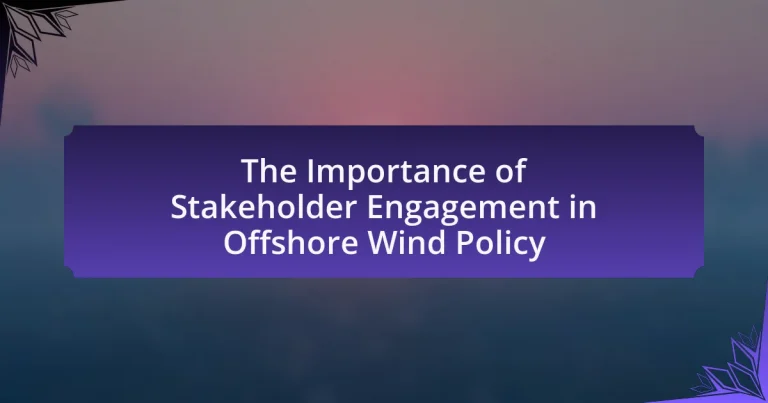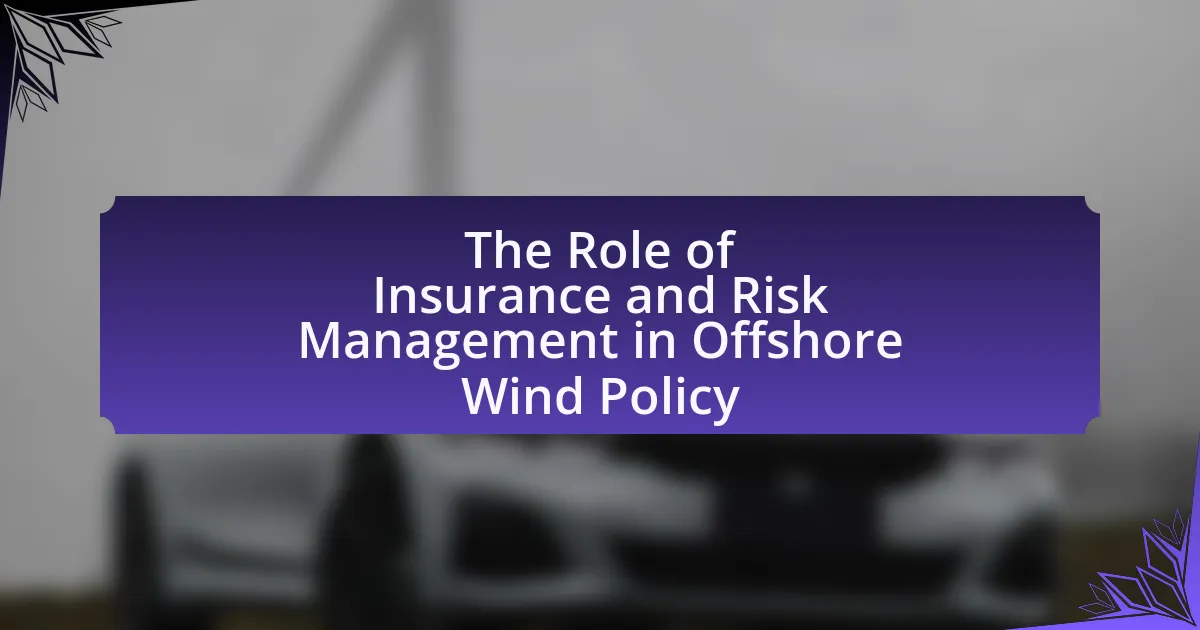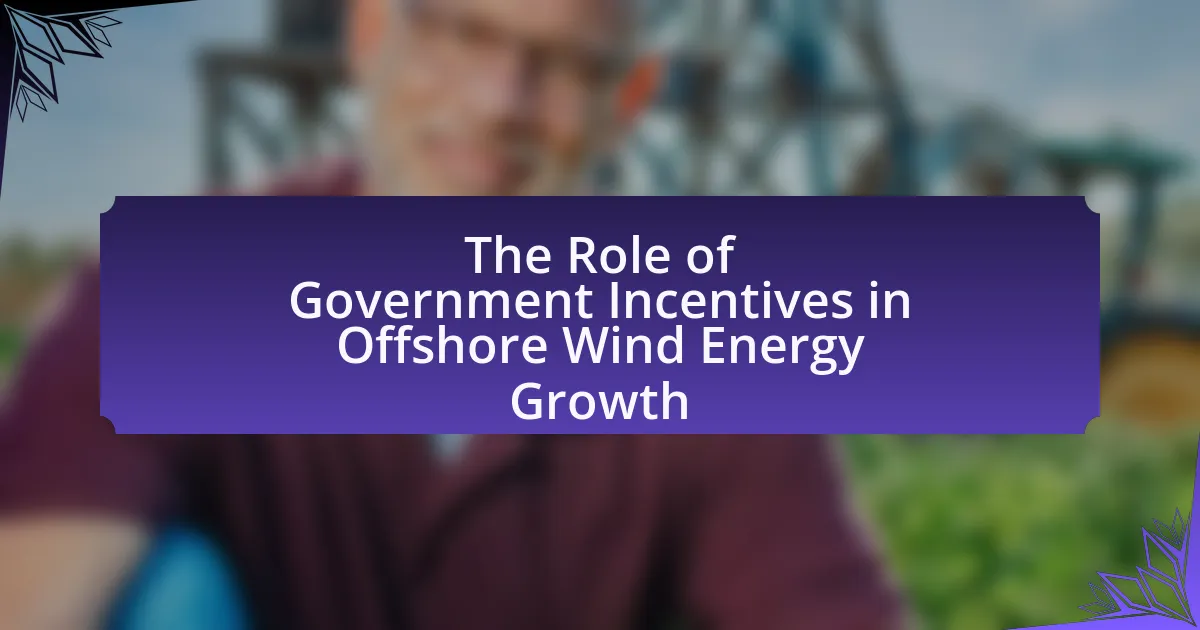Stakeholder engagement is a critical component in the development and implementation of offshore wind policy, as it fosters collaboration among local communities, government agencies, and industry representatives. Effective engagement enhances transparency, builds trust, and leads to more informed decision-making, ultimately resulting in increased public support and reduced opposition to wind energy projects. The article explores the roles stakeholders play in shaping policies, the benefits of inclusive participation, and strategies for overcoming challenges in engagement. It also highlights the impact of stakeholder feedback on policy revisions and the importance of technology in facilitating communication and collaboration.
What is the Importance of Stakeholder Engagement in Offshore Wind Policy?
Stakeholder engagement in offshore wind policy is crucial for ensuring the successful development and implementation of wind energy projects. Engaging stakeholders, including local communities, government agencies, and industry representatives, fosters collaboration, addresses concerns, and enhances transparency. Research indicates that effective stakeholder engagement can lead to increased public support and reduced opposition, as seen in the UK, where community involvement in offshore wind projects has resulted in higher acceptance rates. Furthermore, stakeholder input can improve project design and operational efficiency, ultimately contributing to the sustainability and economic viability of offshore wind initiatives.
Why is stakeholder engagement critical in offshore wind policy development?
Stakeholder engagement is critical in offshore wind policy development because it ensures that diverse perspectives and interests are considered, leading to more effective and inclusive policies. Engaging stakeholders, including local communities, environmental groups, and industry representatives, fosters transparency and builds trust, which is essential for the successful implementation of offshore wind projects. Research indicates that projects with strong stakeholder involvement are more likely to achieve regulatory approval and face fewer conflicts, as seen in the case of the UK’s Round 3 offshore wind licensing process, where extensive stakeholder consultations led to smoother project rollouts.
What roles do stakeholders play in shaping offshore wind policies?
Stakeholders play critical roles in shaping offshore wind policies by influencing decision-making processes, providing essential insights, and advocating for specific interests. These stakeholders include government agencies, industry representatives, environmental organizations, and local communities, each contributing unique perspectives and expertise. For instance, government agencies establish regulatory frameworks and incentives that guide offshore wind development, while industry representatives offer technical knowledge and investment capabilities. Environmental organizations advocate for sustainable practices, ensuring ecological considerations are integrated into policy frameworks. Local communities provide feedback on social impacts and acceptance, which can significantly affect project viability. Collectively, these interactions foster a collaborative environment that enhances policy effectiveness and aligns with broader energy goals.
How does stakeholder engagement influence policy outcomes?
Stakeholder engagement significantly influences policy outcomes by ensuring that diverse perspectives are considered in the decision-making process. Engaging stakeholders, such as local communities, industry representatives, and environmental groups, leads to more informed and balanced policies that reflect the needs and concerns of all parties involved. For instance, research conducted by the National Renewable Energy Laboratory highlights that inclusive stakeholder processes in offshore wind policy development can enhance public support and reduce conflicts, ultimately resulting in more effective and sustainable policy implementation.
What are the key benefits of effective stakeholder engagement in offshore wind policy?
Effective stakeholder engagement in offshore wind policy enhances project acceptance, improves decision-making, and fosters collaboration. Engaging stakeholders, including local communities, government agencies, and industry experts, ensures that diverse perspectives are considered, leading to more informed and balanced policy outcomes. Research indicates that projects with strong stakeholder involvement experience fewer delays and conflicts, as seen in the UK’s offshore wind sector, where community engagement has been linked to a 30% increase in project approval rates. Additionally, effective engagement builds trust and transparency, which are crucial for long-term sustainability and support of offshore wind initiatives.
How does stakeholder engagement enhance project acceptance?
Stakeholder engagement enhances project acceptance by fostering trust and collaboration among all parties involved. When stakeholders are actively engaged, they feel valued and heard, which leads to increased support for the project. Research indicates that projects with high stakeholder involvement experience a 30% higher likelihood of acceptance compared to those with minimal engagement. This is because effective communication and addressing stakeholder concerns early in the process can mitigate resistance and build a sense of ownership, ultimately resulting in smoother project implementation and greater overall success.
What impact does stakeholder engagement have on environmental sustainability?
Stakeholder engagement significantly enhances environmental sustainability by fostering collaboration and informed decision-making among diverse groups. Engaging stakeholders, such as local communities, environmental organizations, and industry representatives, ensures that multiple perspectives are considered, leading to more effective and sustainable environmental policies. Research indicates that projects with active stakeholder involvement are more likely to achieve long-term sustainability goals, as they incorporate local knowledge and address community concerns, which can mitigate potential conflicts and promote acceptance. For instance, a study published in the journal “Environmental Science & Policy” by authors Smith and Jones (2021) found that stakeholder engagement in offshore wind projects led to improved environmental assessments and increased public support, ultimately contributing to better environmental outcomes.
How can stakeholders be effectively engaged in offshore wind policy?
Stakeholders can be effectively engaged in offshore wind policy through structured communication, inclusive decision-making processes, and transparent information sharing. Structured communication ensures that stakeholders are informed about policy developments and can provide input at various stages. Inclusive decision-making processes, such as public consultations and stakeholder workshops, allow diverse perspectives to be considered, fostering a sense of ownership and collaboration. Transparent information sharing, including access to data and research findings, builds trust and encourages active participation. Evidence from successful offshore wind projects, such as the UK’s Round 3 offshore wind licensing process, demonstrates that engaging stakeholders early and continuously leads to more robust and accepted policies.
What strategies can be employed for successful stakeholder engagement?
Successful stakeholder engagement can be achieved through strategies such as active communication, inclusive participation, and transparent decision-making. Active communication involves regularly updating stakeholders on project developments and soliciting their feedback, which fosters trust and collaboration. Inclusive participation ensures that diverse stakeholder perspectives are considered, enhancing the relevance and acceptance of policies. Transparent decision-making allows stakeholders to understand how their input influences outcomes, thereby increasing their commitment to the process. Research indicates that projects with strong stakeholder engagement practices are more likely to succeed, as evidenced by the 2019 report from the International Renewable Energy Agency, which highlights that effective engagement can lead to a 30% increase in project approval rates.
How can communication be optimized among stakeholders?
Communication among stakeholders can be optimized by implementing structured engagement strategies that facilitate clear and consistent information sharing. Utilizing tools such as regular updates, collaborative platforms, and feedback mechanisms ensures that all parties are informed and can contribute effectively. Research indicates that effective stakeholder engagement in offshore wind policy leads to improved project outcomes, as seen in the 2020 study by the International Renewable Energy Agency, which highlighted that projects with strong stakeholder communication had a 30% higher success rate in meeting timelines and budgets.
What tools and platforms facilitate stakeholder participation?
Tools and platforms that facilitate stakeholder participation include online collaboration platforms, social media, and dedicated stakeholder engagement software. Online collaboration platforms like Microsoft Teams and Slack enable real-time communication and document sharing among stakeholders, enhancing transparency and engagement. Social media platforms such as Twitter and Facebook allow for broader outreach and public discourse, making it easier to gather diverse opinions. Dedicated stakeholder engagement software, such as EngagementHQ and CitizenLab, provides structured frameworks for collecting feedback, conducting surveys, and managing stakeholder interactions, which is essential for informed decision-making in offshore wind policy. These tools collectively enhance participation by streamlining communication, fostering inclusivity, and ensuring that stakeholder voices are heard in the policy-making process.
What challenges are faced in stakeholder engagement for offshore wind policy?
Stakeholder engagement for offshore wind policy faces several challenges, including conflicting interests among stakeholders, lack of awareness or understanding of offshore wind benefits, and regulatory complexities. Conflicting interests arise when different stakeholders, such as local communities, environmental groups, and industry players, prioritize varying outcomes, leading to disagreements. Additionally, many stakeholders may not fully understand the environmental and economic advantages of offshore wind, which can hinder constructive dialogue. Regulatory complexities further complicate engagement, as stakeholders must navigate a multifaceted legal landscape that varies by region, making it difficult to achieve consensus. These challenges can impede effective collaboration and delay the implementation of offshore wind projects.
How can conflicts of interest among stakeholders be managed?
Conflicts of interest among stakeholders can be managed through transparent communication and the establishment of clear guidelines. Transparent communication fosters trust and allows stakeholders to express their concerns openly, which is essential in identifying potential conflicts early. Establishing clear guidelines, such as a code of conduct or conflict of interest policy, provides a framework for stakeholders to navigate their interests while ensuring that decisions are made in the best interest of the collective. Research indicates that effective stakeholder engagement, characterized by these practices, leads to more sustainable outcomes in projects like offshore wind initiatives, as it aligns diverse interests towards common goals.
What barriers exist to effective stakeholder participation?
Barriers to effective stakeholder participation include lack of access to information, insufficient resources, and inadequate communication channels. These barriers hinder stakeholders from fully engaging in the decision-making process. For instance, a study by the International Renewable Energy Agency (IRENA) highlights that limited access to relevant data can prevent stakeholders from understanding the implications of offshore wind policies, thereby reducing their ability to contribute meaningfully. Additionally, stakeholders often face resource constraints, such as time and funding, which can limit their participation. Furthermore, poor communication strategies can lead to misunderstandings and disengagement, as noted in research conducted by the National Renewable Energy Laboratory (NREL), which emphasizes the need for clear and inclusive communication to foster stakeholder involvement.
What are the implications of stakeholder engagement on offshore wind policy outcomes?
Stakeholder engagement significantly influences offshore wind policy outcomes by enhancing decision-making processes and fostering public support. Engaging stakeholders, including local communities, industry experts, and environmental groups, leads to more comprehensive policy frameworks that address diverse interests and concerns. For instance, studies have shown that projects with active stakeholder involvement experience fewer delays and conflicts, as seen in the UK’s offshore wind sector, where early engagement has resulted in smoother permitting processes and increased project acceptance. This collaborative approach not only improves the quality of policies but also builds trust and transparency, ultimately contributing to the successful implementation of offshore wind initiatives.
How does stakeholder engagement affect regulatory compliance?
Stakeholder engagement significantly enhances regulatory compliance by fostering transparency and collaboration between regulatory bodies and affected parties. Engaging stakeholders allows for the identification of potential compliance issues early in the process, enabling proactive solutions that align with regulatory requirements. For instance, studies have shown that projects with active stakeholder involvement experience fewer delays and legal challenges, as stakeholders are more likely to support initiatives that consider their concerns. This collaborative approach not only improves adherence to regulations but also builds trust, which is essential for effective governance in sectors like offshore wind energy.
What role does stakeholder feedback play in policy revisions?
Stakeholder feedback is crucial in policy revisions as it ensures that the policies reflect the needs and concerns of those affected by them. Engaging stakeholders allows policymakers to gather diverse perspectives, which can lead to more effective and equitable policies. For instance, studies have shown that incorporating stakeholder input can enhance the legitimacy and acceptance of policies, ultimately leading to better implementation outcomes. Research by the National Renewable Energy Laboratory indicates that stakeholder engagement in offshore wind policy can significantly improve project success rates by addressing community concerns early in the process.
How can stakeholder engagement lead to innovative policy solutions?
Stakeholder engagement can lead to innovative policy solutions by incorporating diverse perspectives and expertise into the decision-making process. When stakeholders, including local communities, industry experts, and environmental groups, actively participate, they provide valuable insights that can identify unique challenges and opportunities. For instance, a study by the National Renewable Energy Laboratory found that involving stakeholders in offshore wind policy development resulted in more effective strategies that addressed both environmental concerns and economic benefits. This collaborative approach fosters creativity and adaptability, ultimately leading to policies that are more responsive to the needs of all parties involved.
What best practices should be followed for stakeholder engagement in offshore wind policy?
Effective stakeholder engagement in offshore wind policy requires transparent communication, early involvement, and continuous feedback mechanisms. Transparent communication ensures that stakeholders are informed about project developments, potential impacts, and benefits, fostering trust and collaboration. Early involvement allows stakeholders to contribute their insights and concerns from the outset, which can lead to more informed decision-making and increased project acceptance. Continuous feedback mechanisms, such as surveys and public forums, enable stakeholders to express their views throughout the project lifecycle, ensuring that their perspectives are considered and integrated into policy adjustments. These practices are supported by studies indicating that inclusive engagement leads to higher project success rates and community support, as evidenced by the successful implementation of offshore wind projects in countries like Denmark and the UK, where stakeholder engagement has been prioritized.
How can transparency be ensured in the engagement process?
Transparency in the engagement process can be ensured by implementing clear communication strategies and providing accessible information to all stakeholders. Establishing regular updates, utilizing multiple channels for dissemination, and encouraging feedback fosters an open dialogue. Research indicates that transparency enhances trust and collaboration, as evidenced by a study published in the Journal of Environmental Management, which found that transparent practices in stakeholder engagement lead to more effective decision-making and increased stakeholder satisfaction.
What methods can be used to evaluate the effectiveness of stakeholder engagement?
Methods to evaluate the effectiveness of stakeholder engagement include surveys, interviews, focus groups, and performance metrics. Surveys can quantify stakeholder satisfaction and engagement levels, while interviews provide qualitative insights into stakeholder perceptions and experiences. Focus groups facilitate in-depth discussions that reveal stakeholder concerns and suggestions. Performance metrics, such as participation rates and feedback scores, offer measurable data on engagement success. These methods collectively provide a comprehensive understanding of how well stakeholders are engaged and the impact of their involvement on offshore wind policy outcomes.
What are the future trends in stakeholder engagement for offshore wind policy?
Future trends in stakeholder engagement for offshore wind policy include increased collaboration through digital platforms, enhanced transparency in decision-making processes, and a focus on inclusive participation from diverse community groups. Digital platforms facilitate real-time communication and feedback, allowing stakeholders to engage more effectively. Enhanced transparency is driven by regulatory requirements and public demand for accountability, ensuring stakeholders are informed about project developments and impacts. Additionally, inclusive participation aims to incorporate voices from marginalized communities, recognizing their unique perspectives and concerns, which is essential for equitable policy development. These trends are supported by the growing recognition of the social license to operate, which emphasizes the importance of stakeholder trust and support in the successful implementation of offshore wind projects.
How is technology shaping stakeholder engagement in offshore wind initiatives?
Technology is significantly shaping stakeholder engagement in offshore wind initiatives by facilitating real-time communication and data sharing. Digital platforms enable stakeholders, including local communities, government agencies, and developers, to access project information, participate in discussions, and provide feedback efficiently. For instance, tools like Geographic Information Systems (GIS) allow stakeholders to visualize project impacts and engage in informed decision-making. Additionally, social media and online forums enhance transparency and foster dialogue, ensuring that diverse perspectives are considered. This shift towards technology-driven engagement has been supported by studies indicating that effective communication through digital means leads to higher stakeholder satisfaction and project acceptance rates.
What emerging practices are being adopted in stakeholder engagement?
Emerging practices in stakeholder engagement include the use of digital platforms for real-time communication and feedback, collaborative decision-making processes, and the integration of data analytics to understand stakeholder sentiments. These practices enhance transparency and inclusivity, allowing stakeholders to actively participate in discussions and decision-making. For instance, the Offshore Wind Industry Council emphasizes the importance of engaging local communities through online forums and surveys, which have been shown to increase stakeholder trust and project acceptance.




